Video-Based Learning: Benefits, Examples, and Implementation
Video-based learning improves employee engagement, reduces cost, and improves scalability. Learn how to utilize it to improve workplace training.
Video-based learning improves employee engagement, reduces cost, and improves scalability. Learn how to utilize it to improve workplace training.

In a world where screens dominate our daily lives, videos have become the go-to medium for learning. From corporate boardrooms to virtual classrooms, video-based learning has transformed the way we train and upskill.
Whether you’re onboarding new hires, educating clients, or rolling out company-wide training programs, training videos deliver information in a clear, concise manner. Industry statistics reveal 83% of people prefer learning via videos rather than text.
This visual power leads to enhanced employee engagement and retention, which positively impacts the ROI. Keep reading to learn what video-based learning is, why it works so well, and how you can implement it to keep your training programs relevant.
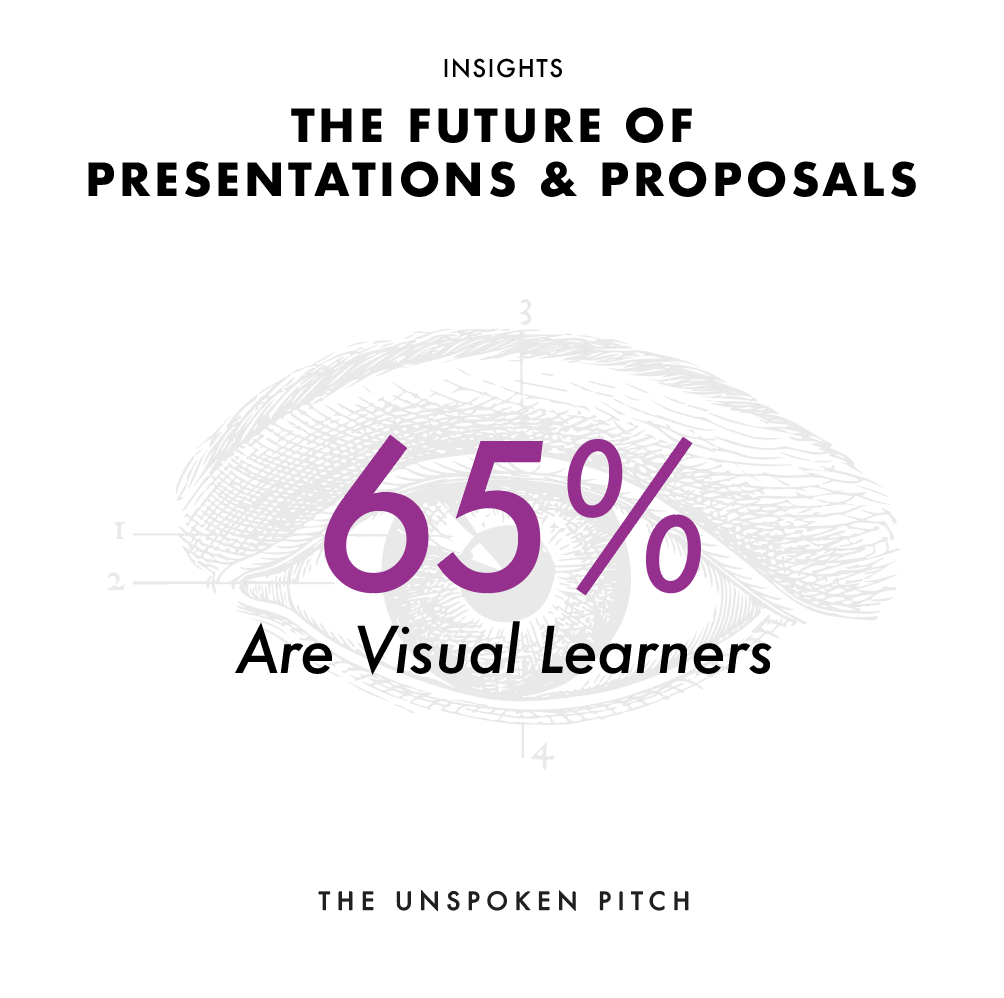
Video-based learning is a modern training approach that delivers educational content through videos. The videos may be animated explainers, how-to tutorials, recorded lectures, or interactive modules. As long as the picture is moving, any type of video format can be used for learning.
Unlike traditional methods such as lengthy text manuals or in-person seminars, video-based learning offers a more flexible and learner-friendly experience. It supports self-paced learning, allowing users to pause, rewind, and revisit concepts as needed.
Human psychology is one reason why video learning is so effective. Research shows that 65% of people are visual learners. This means that most people retain information better when it’s delivered through visual formats, such as videos. Video-based learning leverages this approach by combining visuals, voiceovers, and storytelling. It also incorporates real-world examples to facilitate deeper understanding and long-term knowledge retention.
With most of us constantly scrolling through visual content on our phones, the preference for video-based learning is not surprising. It mirrors how people usually consume information and creates an immersive learning experience. Here’s why most organizations are switching to video-based learning:

Videos are naturally more captivating than static text. They bring concepts to life through motion, visuals, and sound. This multisensory approach makes complex topics more accessible and easier to understand. From a learner’s perspective, watching a video feels more like watching a story unfold than attending a lecture.
A report by Forrester Research found that employees are 75% more likely to watch a video than read documents, emails, or articles. This strong preference for videos helps learners stay focused, complete training faster, and apply it to real-world situations.
Since the human brain prefers visual content, multimedia formats may appeal to it, making video an ideal learning medium.
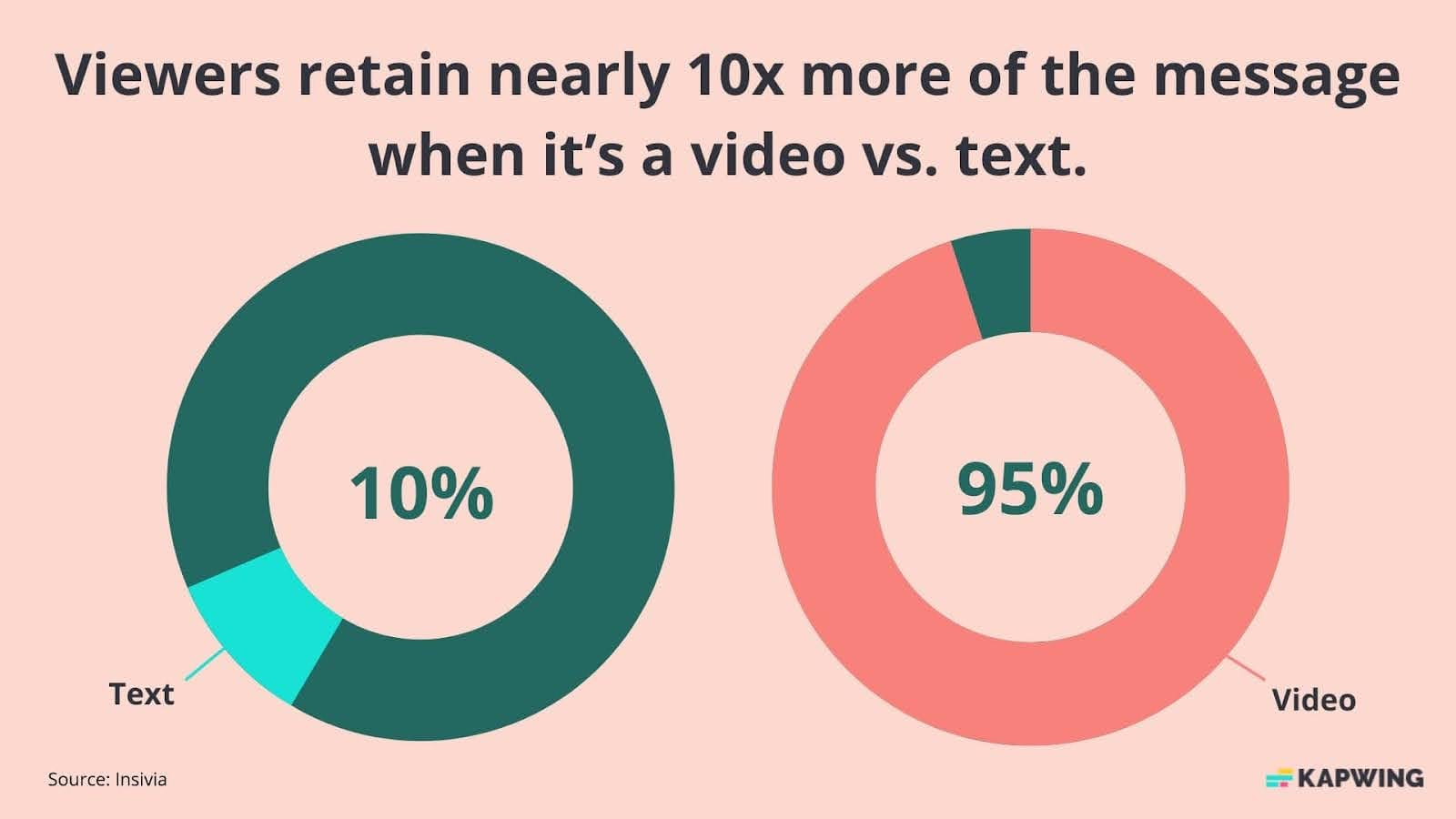
According to Mayer’s 12 principles of multimedia learning theory, our brain processes information through two main channels: Auditory and Visual. Videos leverage both simultaneously, activating what’s known as dual-channel processing. This helps reinforce important concepts and enhances long-term memory.
Learners retain 95% of a message when they watch a video, compared to only 10% when they read it as text. That’s because watching a concept demonstrated in real-time makes it easier to grasp. By catering to how the brain prefers to learn, videos make knowledge more memorable and impactful.
In a hybrid or remote work environment, flexibility is a necessity. Video-based learning contributes to it by allowing learners to access content on their schedule, from any device and location. This on-demand access enables personalized, uninterrupted learning.
Learners can pause, rewind, and revisit sections as often as needed, helping them absorb information at their own pace. As they can resume exactly where they left off, video-based courses often see much higher completion rates than traditional, time-bound training sessions.
Training large teams across different departments or locations can be a logistical nightmare with traditional methods. Video-based learning addresses this by providing a scalable solution that delivers high-quality training to everyone, regardless of their location or schedule.
Once a training video is created, it can be used repeatedly without the need for an instructor or a venue reservation. This means you can onboard hundreds, or even thousands, of employees with the same content, ensuring consistency across your organization.
While the initial investment for high-quality videos may seem steep, the long-term savings quickly outweigh the cost. Traditional in-person training requires ongoing expenses like venue booking, instructor fees, printed material, and traveling costs. Video-based online training removes most of these barriers by moving everything online.
A report by Brandon Hall Group reveals that companies can save an average of $108 per employee by switching from traditional learning to eLearning. Additionally, it saves operational costs and resources by reducing training time. You can continually update the digital training content to keep your training current, without incurring additional costs or scheduling challenges.
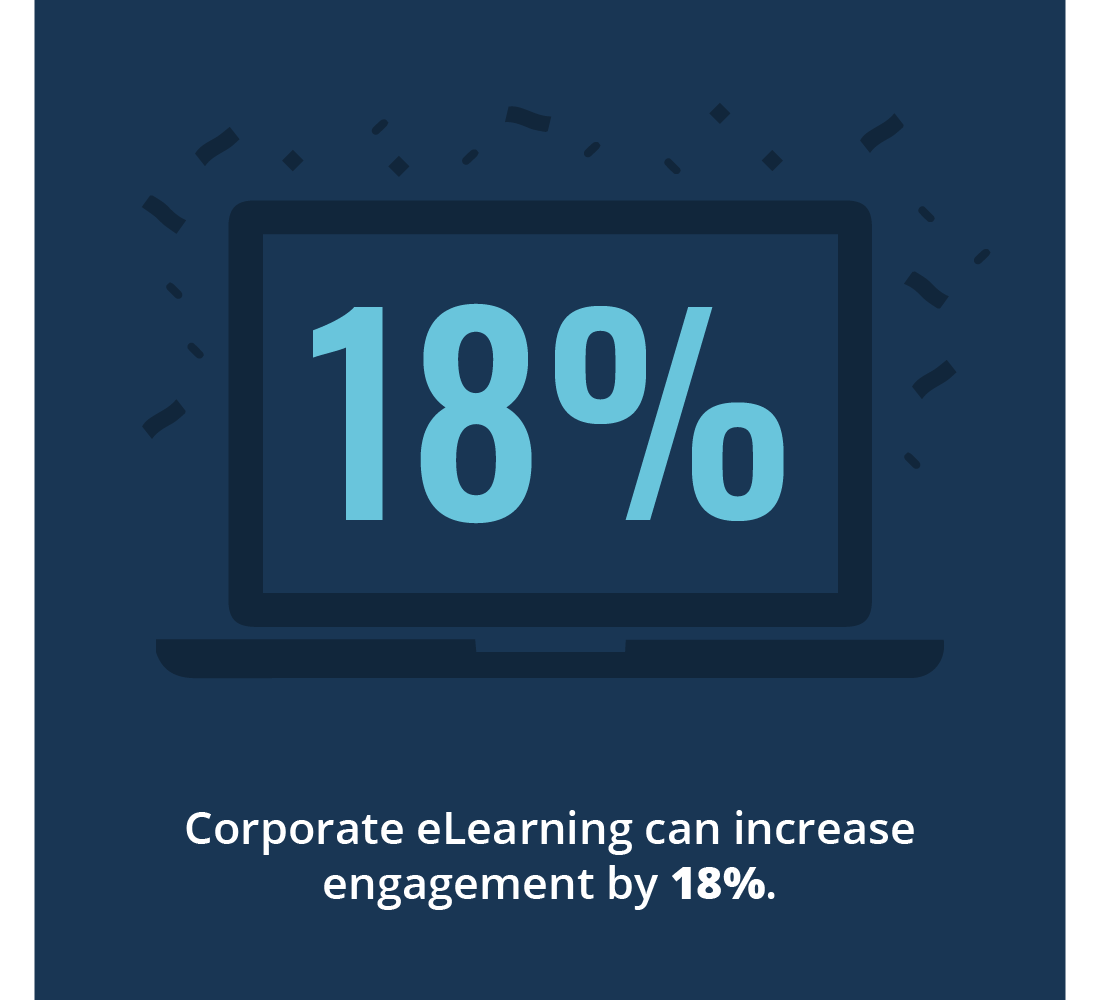
One of the biggest advantages of video-based learning is its versatility. You can tailor it to meet different training needs, audiences, and learning outcomes. Let’s break down some of the most effective types of video-based learning used by companies and training professionals:
Animated tutorials are ideal for simplifying technical topics into clear, bite-sized visuals. They use a mix of animation, voice-over narration, and simple storytelling to deliver information in an easy-to-understand manner. Animated videos are especially useful when you’re dealing with concepts that are difficult to demonstrate with real-world footage.
These are short, focused videos that present a single idea, product, or process in a clear, compelling way. Explainers work well when introducing new tools, policies, or features to employees or clients. They’re perfect for capturing attention in a short window, helping learners absorb the core message without information overload.
Interactive videos are one of the most engaging formats in video-based learning, which allows learners to participate in the experience actively. These might include clickable prompts, quizzes, a storyline, or decision-making scenarios. The idea is to transform passive viewing into active participation. For example, a training video pauses mid-way to ask viewers how they would handle a specific situation.
Microlearning is all about quick, focused, and actionable content. These are short, targeted videos, typically between 2–5 minutes long, that explain a single learning objective.
Microlearning videos are ideal for Just-in-Time Learning, enabling employees to access quick help when needed. This includes learning how to reset a password or navigate through a professional dashboard.
By using real-life situations, scenario-based videos immerse learners in realistic situations to help them enhance decision-making and interpersonal learning.
These videos are particularly effective in developing essential soft skills, including communication, leadership, and customer service. The learners are exposed to a safe environment with simulated scenarios, allowing them to practice their judgment and responses.
When choosing between text-based and video-based learning, it’s important to understand that each format offers distinct advantages. This table compares the two formats across key features to help you understand the differences between the two:
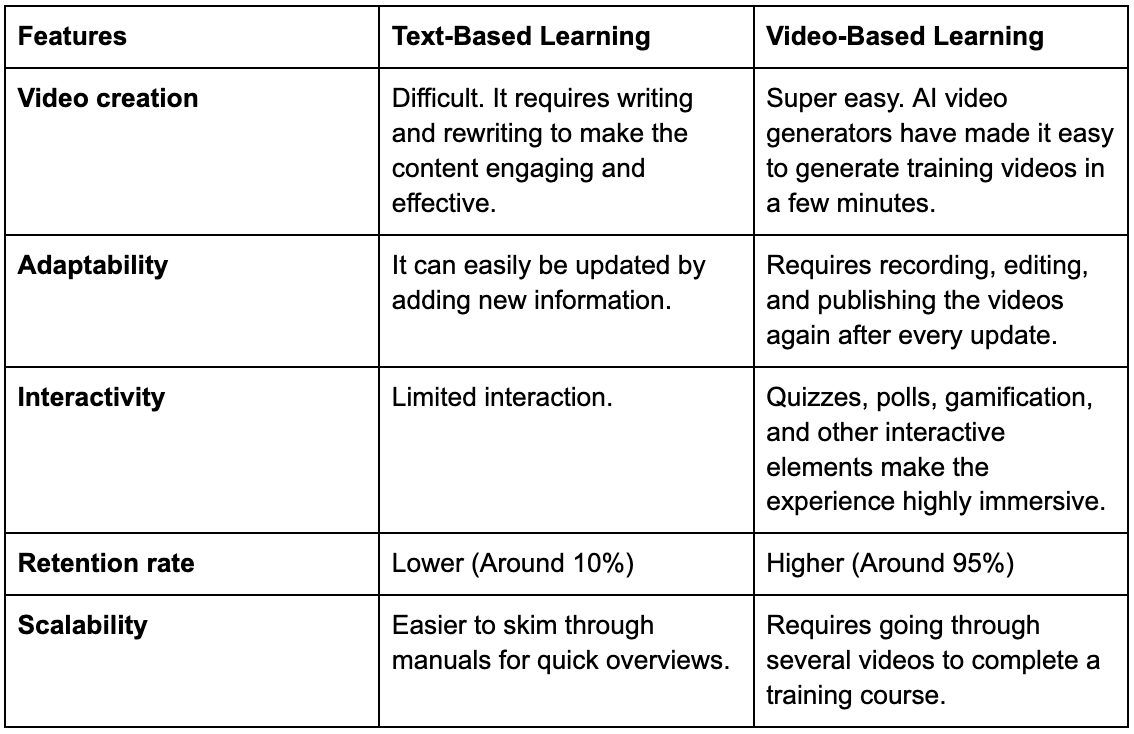
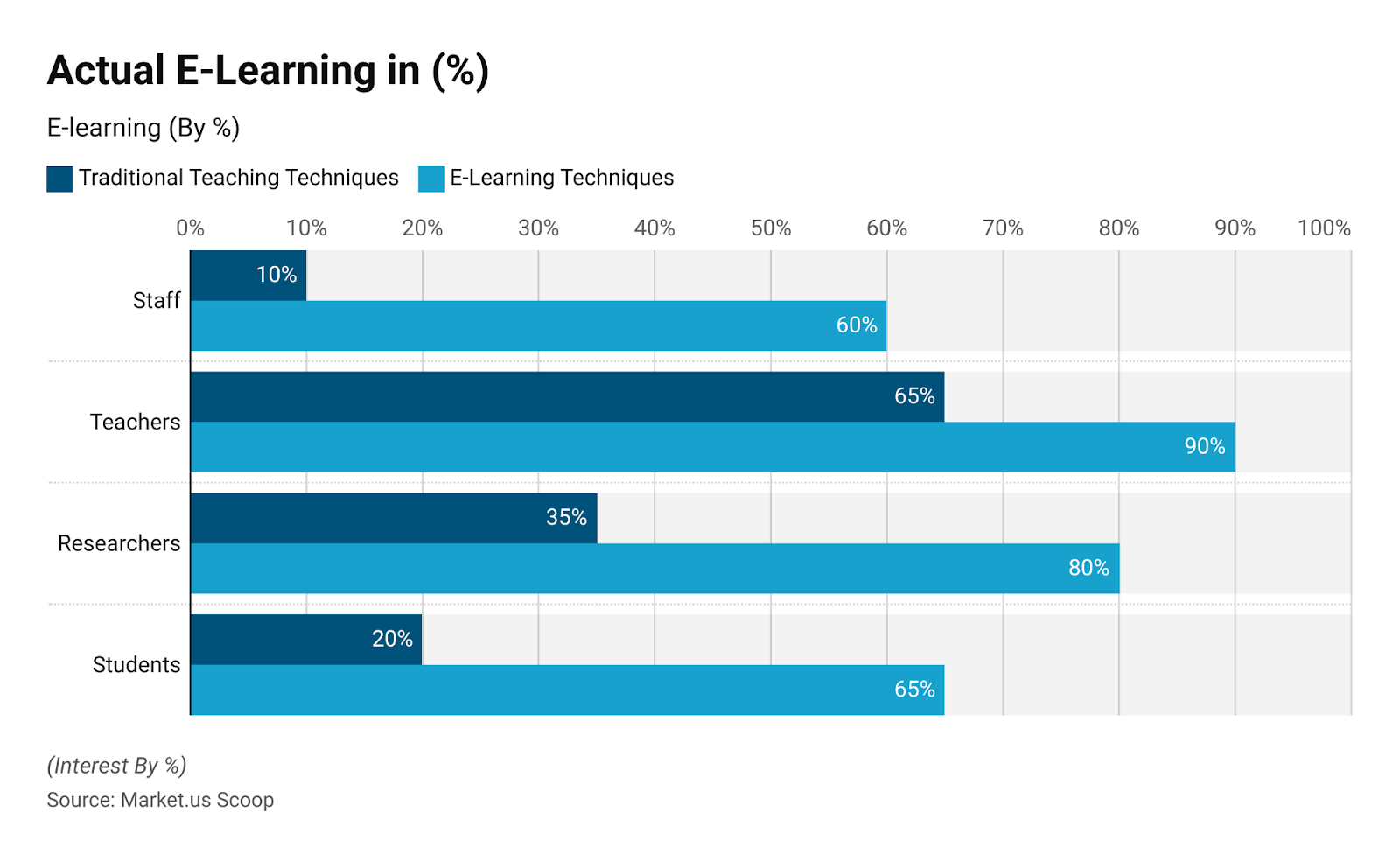
Switching to video-based learning might seem like a big shift, especially if your team is used to traditional classroom training. But with the right strategy and tools, you can easily incorporate it into your training programs.
Before you hit record, define what you want your audience to walk away with. Your video should have a clear purpose, whether to teach a process or improve a skill. Well-defined learning objectives help shape the script, visuals, and structure of each video.
For instance, if your goal is to train new employees on company policies, outline what they need to understand and what actions they should be able to take as a result. A clearly outlined objective keeps the content focused and prevents information overload.
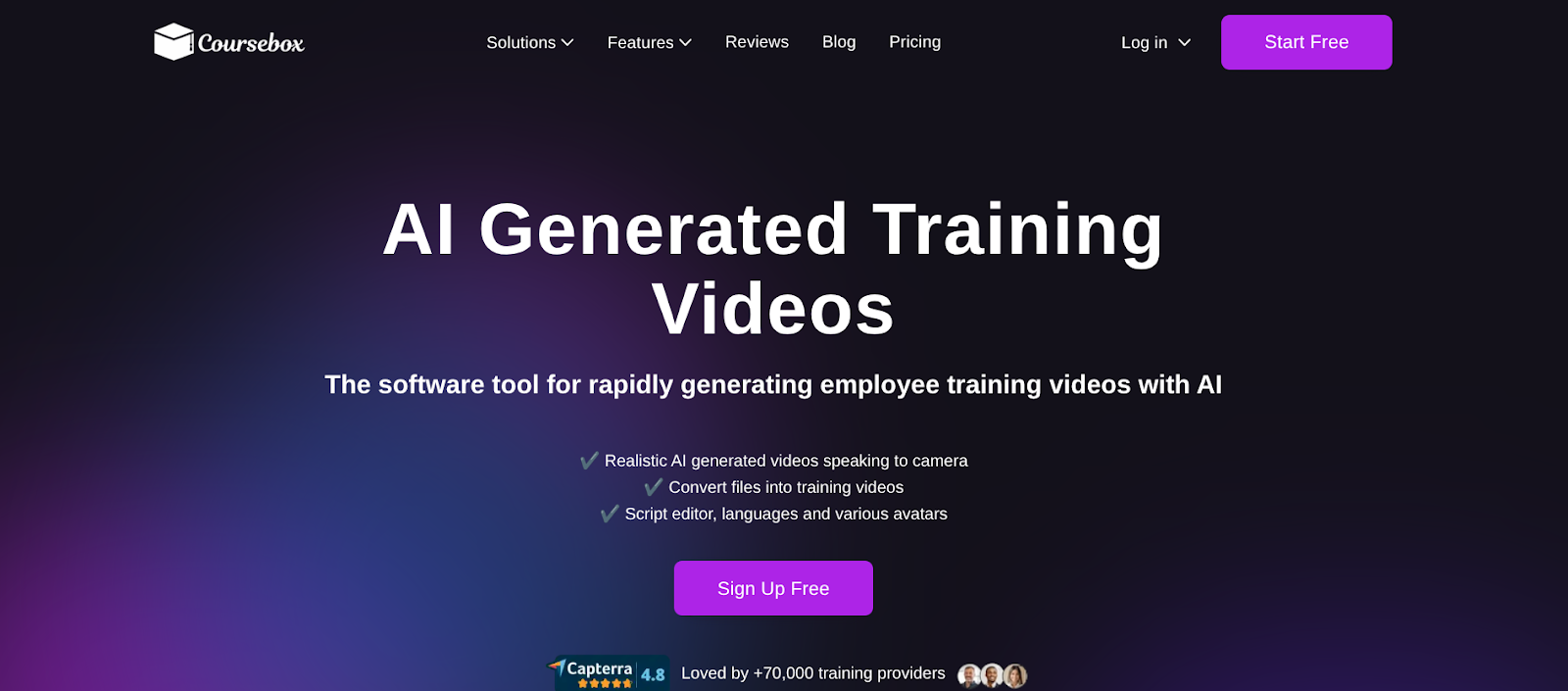
Since there’s no in-person instructor guiding learners in real-time, it’s essential to select the right tools to facilitate their learning. You can either record, edit, and publish the videos yourself or opt for AI-generated training videos.
AI-generated training videos save you a significant amount of time, money, and energy. Instead of hiring presenters, renting studios, adding subtitles and music, and other details, you can easily create an AI-generated training course with platforms like Coursebox.
Coursebox AI-generated videos:
Coursebox offers software that allows you to generate AI videos with just a click. It helps you create an engaging training course by converting your files into training videos that can be edited or translated into different languages.

The average attention span of an adult human is approximately 8 seconds. Thus, it’s essential to capture your audience’s interest within these 8 seconds to ensure they complete their training. One way to achieve this is by breaking down topics into concise, 6-8 minute modules. You can use real-life examples, animation, and subtitles to explain key concepts.
To boost engagement, incorporate interactive sessions within the video. Mid-session, short quizzes or prompts that ask learners to reflect on what they’ve learned help sustain attention. You can even add gamification elements, such as badges or points, to keep your audience engaged.
Learners should be able to access the videos from anywhere. The videos must be compatible across all types of devices, including laptops, mobile phones, tablets, and desktops. After designing your course, test the videos across various platforms to ensure the layout and quality remain consistent.
Consider offering a low-resolution version for learners with limited connectivity. Compress the video by reducing audio and image quality, which lowers data consumption. This ensures everyone, regardless of bandwidth, can fully participate in training.
Once your video training program goes live, actively seek learner feedback. Use surveys, polls, or feedback forms to gather input about content clarity, pacing, and relevance. You can also check the LMS analytics to track engagement, completion rates, and quiz scores to determine the course's success.
If you notice learners dropping off before a video ends or scoring low on post-video quizzes, it may be time to tweak the content. Perhaps the videos are too long, too complex, or lack better visuals and examples. Based on learners' feedback, you can trim the videos, adjust the pace, and add better examples to simplify the topics.
Learning is no longer confined to lengthy manuals and static presentations. Video-based learning offers the perfect mix of clarity, relevance, and speed. It turns learning into an experience that aligns with the demands of modern workplaces.
Training videos serve as a strategic asset, enhancing knowledge retention, improving performance, and establishing a culture of continuous learning. With Coursebox, you don’t have to worry about anything. Its AI-powered platform helps you design custom courses your team will actually enjoy and complete.
Start your free trial with Coursebox today and build a training course tailored for your audience!
Videos engage both the visual and auditory senses, helping the audience stay focused for longer periods. They simplify complex topics through animations, how-to tutorials, storytelling, and real-world examples, making the content more accessible and easier to understand. Even research proves that the human brain processes visuals faster than text, which is why video-based learning is more effective.
You can use videos for teaching in several ways:
It depends on how your audience prefers to learn. For visual learners, video-based learning offers higher engagement and retention. The flexibility allows them to learn wherever and whenever feasible. Furthermore, it is highly scalable, making it a practical solution for remote teams and growing organizations.
Videos combine visual and auditory learning styles that appeal to learners who absorb information best through images, motion, and sound. It uses visual cues, animated explanation, and interactive elements to enhance understanding and retention.
Some tools that can help you implement video-based learning include Coursebox, Kaltura, Camtasia, Powtoon, and Vyond. These platforms help you create engaging videos and animations for your employees. However, Coursebox stands out by combining AI-powered video course creation, employee feedback, and an AI-quiz generator in a single platform.
